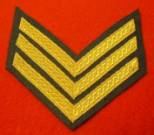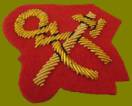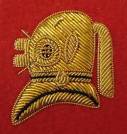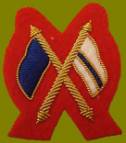No10 DRESS MESS TEMPERATE 1970-1991
Mess uniforms first appeared in the British Army in about 1845. The original purpose was to provide a relatively
comfortable and inexpensive alternative to the stiff and elaborate full dress uniforms then worn by officers for evening
social functions such as regimental dinners or balls.
With the general disappearance of full dress uniforms after World War I, mess dress became the most colourful and
traditional uniform to be retained by most officers in British and Commonwealth armies. Immediately after World War II
the cheaper "blue patrols" were worn for several years as mess dress, but by 1956 the traditional uniforms had been
readopted.
The formal designation of the most commonly worn mess uniform in the British Army is "No 10 (Temperate) Mess Dress". The
form varies according to regiment, corps or service, but generally a short mess jacket is worn, which either fastens at
the neck (being cut-away to show the waistcoat — this being traditionally the style worn by cavalry regiments), or is worn
with a white shirt and black bow tie (traditionally the usual style for all other regiments, corps and services). Since the
regimental amalgamations of recent years, the "cavalry style" jacket has been adopted by some British Army regiments and
corps, such as the Adjutant General's Corps, the Royal Logistic Corps the Devonshire and Dorset Regiment, and the Royal
Gloucestershire, Berkshire and Wiltshire Regiment amongst others. Officers of the Brigade of Guards, the regiments of
which have escaped amalgamation, still wear the "infantry style" of jacket; as do the Royal Engineers, the Parachute
Regiment, the Royal Army Medical Corpsand the Royal Regiment of Scotland.
STAFF SERGEANT'S MESS DRESS

The colours of mess jackets and overalls almost inevitably reflect those of the traditional full dress uniforms of the
regiments in question, as worn until at least 1914. Jackets are therefore usually scarlet, dark blue or rifle green,
with collars, cuffs, waistcoats or lapels in the former facing colours of the regiments in question. In the case of those
regiments which have undergone amalgamation features of the former uniforms are often combined. This results in the mess
uniform of a modern regiment with several predecessors may have cuffs and lapels of differing colours. Waistcoats (vests)
are often richly embroidered though with modern substitutes for the gold or silver braiding that made these items very
expensive prior to World War II. Non-commissioned officers wear a mess dress that is usually simpler in design but in the
same regimental colours as officers of the same regiment. All chevrons and qualification badges are of gold thread.
MESS DRESS SERGEANT CHEVRONS

MESS DRESS TRADE QUALIFICATION BADGES
PARACHUTE WINGS |
REME ARTICIFER |
|
ADVANCED DIVER |
SIGNALS TRAINED |
Most British Army regiments' mess dress incorporates high-waisted, very tight trousers known as "overalls", the bottoms of
which buckle under heeled boots (or "mess wellies"). Ornamental spurs are usually worn in cavalry regiments; some other
regiments and corps prescribe spurs for "field officers" (majors and above), since in former times these officers would
have been mounted. Scottish regiments wear kilts or tartan trews, and some wear tartan waistcoats as well.
In "No 11 Warm Weather Mess Dress" a white drill hip-length jacket is worn with either a waistcoat in the same material
or a cummerbund of regimental pattern. Blue and various shades of red or green are the most common colours for the
cummerbund. Trousers or overalls are the same as in No 10 Dress.